Coaching Leaders
The Appleton Greene Corporate Training Program (CTP) for Coaching Leaders is provided by Dr. Jinks, PhD, MBA, BCC Certified Learning Provider (CLP). Program Specifications: Monthly cost USD$2,500.00; Monthly Workshops 6 hours; Monthly Support 4 hours; Program Duration 12 months; Program orders subject to ongoing availability.

Personal Profile
As an award-winning professional photographer, Dr. Jinks knows the value of viewing challenges through the right lenses to achieve success. After a successful 22-year career in organizational leadership, Dr. Jinks changed lenses to serve leaders from another perspective. Today, he coaches and trains leaders and coaches in both the social and corporate sectors. He is Founder and President of a coaching and training organization based in Columbia, SC. Dr. Jinks is a multi-best-selling author and member of the National Association of Experts, Writers, and Speakers. This Coaching Leaders program is based on Dr. Jinks’ Organizational Leadership Coaching Training (OLCT), a 30-hour, CCE-accredited online program that certifies coaches.
With a Ph.D. in Organizational Leadership, Dr. Jinks regularly contributes to Forbes.com as a member of the Forbes Coaches Council. He is a Board Certified Coach, certified adjunct coach and trainer with Leadership Systems, Inc., and certified Influencer™ trainer with VitalSmarts®. He is also certified as an Academy of Choice coach. He is a teaching supporter of the Right Question Institute and holds a Harvard Business School Certificate in using the Question Formulation Technique™ (QFT).
Dr. Jinks has been featured as a GameChanger® and a Master of Success® in USA Today and The Wall Street Journal respectively, for his fresh take on strategy and leadership through a strategic coaching continuum. He was recognized as one of the Top 10 Most Influential People in Leadership Coaching by CIO Views Magazine, and as one of the 10 most successful leadership coaches to watch in 2024 by Enterprise Wired Magazine. His speaking stages range from The Citadel to Universal Studios, and from TEDx to The United Nations. Dr. Jinks’ globally-acclaimed podcast, The Leadership Window is a Feedspot Top-10 podcast for social sector leadership.
Dr. Jinks’ rapid success as a coach earned him a spot as keynote speaker at the Global LEAP Summit and an invitation to co-author a book, along with such master coaches as Marshall Goldsmith, Mark Thompson, Marc Steinberg, and Chicken Soup for the Soul creator Jack Canfield. Dr. Jinks’ work with Canfield on their second collaborative book achieved Amazon best-seller status in its first week and earned Dr. Jinks an Editor’s Choice Award for his contribution. Dr. Jinks’ signature solo work is titled “Strategic Fail: Why Nonprofit Strategic Planning Fails, and How to Fix It,” which premiered on Amazon as a #1 New Release in February 2018. The 2nd edition is currently in development.
To request further information about Dr. Jinks through Appleton Greene, please Click Here.
(CLP) Programs
Appleton Greene corporate training programs are all process-driven. They are used as vehicles to implement tangible business processes within clients’ organizations, together with training, support and facilitation during the use of these processes. Corporate training programs are therefore implemented over a sustainable period of time, that is to say, between 1 year (incorporating 12 monthly workshops), and 4 years (incorporating 48 monthly workshops). Your program information guide will specify how long each program takes to complete. Each monthly workshop takes 6 hours to implement and can be undertaken either on the client’s premises, an Appleton Greene serviced office, or online via the internet. This enables clients to implement each part of their business process, before moving onto the next stage of the program and enables employees to plan their study time around their current work commitments. The result is far greater program benefit, over a more sustainable period of time and a significantly improved return on investment.
Appleton Greene uses standard and bespoke corporate training programs as vessels to transfer business process improvement knowledge into the heart of our clients’ organizations. Each individual program focuses upon the implementation of a specific business process, which enables clients to easily quantify their return on investment. There are hundreds of established Appleton Greene corporate training products now available to clients within customer services, e-business, finance, globalization, human resources, information technology, legal, management, marketing and production. It does not matter whether a client’s employees are located within one office, or an unlimited number of international offices, we can still bring them together to learn and implement specific business processes collectively. Our approach to global localization enables us to provide clients with a truly international service with that all important personal touch. Appleton Greene corporate training programs can be provided virtually or locally and they are all unique in that they individually focus upon a specific business function. All (CLP) programs are implemented over a sustainable period of time, usually between 1-4 years, incorporating 12-48 monthly workshops and professional support is consistently provided during this time by qualified learning providers and where appropriate, by Accredited Consultants.
Executive summary
Coaching Leaders

Today’s executive leaders increasingly seek to develop leaders as intentionally as they seek to develop and train managers. Managers monitor projects, process, and systems. They supervise people. They analyze and report. Leaders do different things. They instill vision, inspiration, and empowerment in people. They engage, challenge, and develop people. This work requires a very different skill set than that of managers. The Coaching Leaders Program addresses this need by teaching leaders to coach those leaders they are striving to develop.
Two significant leadership theories continue today to provide a foundation for leadership coaching: Self-Determination Theory and Transformational Leadership Theory. The focus of the former is on the fundamental human desire for autonomy, competence, and relatedness, whereas the latter – simply put – distinguishes leadership from management. Coaching Leaders focuses heavily on these two leadership tenets because we train leaders to create an environment where their teams can experience self-determination. The act of management alone cannot achieve this. Coaching is the most powerful tool to promote self-determination, and it is one of the primary behaviors of transformational leaders. This program trains leaders to differentiate between managing, directing, monitoring, supervising, telling, etc. and the core discipline of coaching.
Coaching within organizations has become more accessible to a wider range of individuals, extending beyond top executives to include mid-level managers. Companies have come to recognize the value of cultivating coaching skills in their leaders to cultivate a more inclusive, supportive, and high-performing organizational culture. Many companies invest significant portions of their training and development budgets on external leadership coaches. However, the downsides of hiring external leadership coaches include higher costs and the limitations for creating a coaching “culture” from the outside. Consequently, training programs for internal coaches are seeing a significant increase.
Technology integration in coaching is becoming increasingly prevalent. Coaching sessions are now more accessible than ever, thanks to the use of digital platforms. The rapid advancement of technology has been greatly influenced by the widespread adoption of remote work due to the COVID-19 pandemic. However, technology is the platform – not the skill set. Armed with the principles taught in Coaching Leaders, your leaders can coach effectively, regardless of the communications platform used.
Training leaders to coach effectively is much more than a value-add. It provides competitive advantage for those companies who invest in it. There is now an abundance of longitudinal research that points to the evidence that coaching increases organizational performance in many ways. As per the International Coach Federation, the global coaching industry reached a staggering value of $4.5 billion in 2022, showcasing substantial investment. According to a survey conducted by the Human Capital Institute and the International Coach Federation, a significant majority of organizations with robust coaching cultures have reported above-average revenue compared to their peers. Numerous empirical studies have shown the relationship between coaching and key indicators like retention, productivity, engagement, effective decision-making, conflict resolution, and more. To seize the opportunities illuminated by this research, Coaching Leaders is designed to include researched content taught in major credentialing entities like the International Coach Federation and The Center for Credentialing and Education.
Coaching is invaluable in ensuring that leaders are well-equipped with the necessary skills, with a particular focus on emotional intelligence, cross-cultural communication, and virtual team leadership. As an illustration, Self-Determination Theory suggests that employees desire a strong sense of connection, identity, and relatedness with both the mission of their organization and their leaders. Achieving such connection is becoming ever more difficult as we lose human touch and emotional connection with the rise of virtual and remote work.
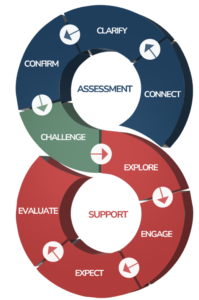
Coaching Leaders infuses training in leadership and training in coaching to equip organizational leaders at any level to help their team leaders fully achieve self-determination and fulfillment, leading to greater value for the employer. Program participants will learn the fundamental elements of coaching, starting with our 8-Step Coaching Cycle, which provides an intentional framework for effectively leading leaders from current status to improved status as a leader.
In the Assessment section of the model, coaches will learn to make more meaningful connections with their coachees, gain clarity on goals and current inventory of leadership strengths and weaknesses, and gain commitment to a plan of action.
The Challenge stage stretches the thinking of the coachee. It pulls them to higher intentionality and clarity.
Finally, the support phase teaches coaches to help their coachee explore ideas and solutions, engage them in the thinking, and helps them be accountable through expectation. The coach and coachee then evaluate progress together along the way, and repeat the cycle.
In addition to the core model, participants will learn the ethical and legal dimensions of coaching, how to handle difficult coachees, how to use powerful questions to draw out and elevate the coachee’s best thinking, and how to lead the coachee through meaningful change toward more effective leadership.
To summarize, since coaching is such a powerful tool in the right hands, our theory holds that it cannot be left to chance, personality, or organic development alone. It must be learned, practiced, and operationalized. Coaching Leaders will teach your leaders the seminal skill set that will lead your team to greater effectiveness, deeper engagement, higher productivity, self-accountability, retention, continuity, and much more.
Curriculum
Coaching Leaders – Part 1- Year 1
- Part 1 Month 1 Coaching Introduction
- Part 1 Month 2 Coaching Tenets
- Part 1 Month 3 Questions & Listening I
- Part 1 Month 4 Questions & Listening II
- Part 1 Month 5 Using Assessments
- Part 1 Month 6 Coaching Engagement
- Part 1 Month 7 Ethical Considerations
- Part 1 Month 8 Transformational Leadership
- Part 1 Month 9 Coaching Challenges
- Part 1 Month 10 Coaching Culture
- Part 1 Month 11 Employee Engagement
- Part 1 Month 12 Review & Action
Program Objectives
The following list represents the Key Program Objectives (KPO) for the Appleton Greene Coaching Leaders corporate training program.
Coaching Leaders – Part 1- Year 1
- Part 1 Month 1 Coaching Introduction – In this introductory workshop, participants will begin to understand how coaching differs from other management disciplines. This module will cover a brief history outlining the evolution of coaching as a practice and highlighting some of the research on the impact of leadership coaching in the workplace. Participants will be exposed to the differences between coaching, consulting, and counseling. This workshop will also highlight the different types of coaching and help participants understand the unique nuances of leadership coaching. In addition to defining leadership coaching, participants will also be introduced to the basic tenets of leadership, from definitions to various theories to diverse styles. The critical aspect of this program is that it centers on leadership coaching as opposed to health coaching, business coaching, performance coaching, et cetera. In order to be effectively trained in leadership coaching, one must first have a full grasp of the overall objective, which is the development of leadership among the organization’s people. The overarching objective of this orientation workshop is to get participants comfortable with the concept of coaching as an optional and powerful tool for leading and managing others. Activities will include role plays, foundational tenets of leadership, and short case studies on identifying the differences between coaching and other managerial tools and disciplines. This module will also serve to prepare participants for the content that will be covered throughout the course. Emphasis is placed on the notion that this program is designed to teach leaders to coach other leaders to be better leaders.
- Part 1 Month 2 Coaching Tenets – This workshop will introduce participants to the foundational coaching model that will be used throughout this program, entitled the 8-Step Coaching Cycle. During this session, we will cover the first of three primary sections of the model, which is the assessment phase. Three of the eight steps in the coaching cycle reside in this assessment phase. First, participants will learn the value and importance of forming a human connection with their coachee, both in long-term relationships and as the initial step in each one-on-one session. Next, program participants will learn the techniques used to gain clarity from the coachee on their articulated challenges, goals, and aspirations. The clarifying step in the cycle also applies to ensuring that the coachee fully and accurately interprets their assessment results in a way that informs their goal setting. Finally, participants will learn and practice the third step in the assessment phase of the cycle – confirm. In this step, the coach artfully and skillfully uses questions to gain confirmation from the coachee on the goals that will be pursued during the coaching engagement. This is also the beginning a drawing out and elevating commitment toward these goals from the coachee.
- Part 1 Month 3 Questions & Listening I – This workshop introduces the two primary skills needed to effectively coach leaders: questioning and listening. Since coaching is not advising or consulting, the conversations are not centered on the coach having the answers. Rather, the coaching engagement consists of the coach asking powerful, relevant, challenging questions that draw out and elevate the coachee’s best thinking. Participants will learn some of the science behind the impact of a question, and they will become acquainted with the various categories of questions that coaches use at various stages of the engagement. In this first look at the use of questions, participants will learn the framework of appreciative inquiry, which focuses on assets and possibilities rather than obstacles, challenges, and barriers. One of the rules of coaching covered in the second workshop is that listening follows questioning. For this reason, this workshop will also focus on the concepts of active listening. Participants will gain practical tips and practice application. This workshop will also introduce participants to the second phase of the 8-step coaching cycle, the challenge phase. In this phase, coaches learn to question the answers rather than answer the questions. This section will teach coaches the value and practice of challenging the coachee’s assumptions and stretching their thinking to higher levels. As in each of the workshops, participants will engage in highly interactive coaching role plays to practice the use of questions, appreciative inquiry, and navigating the challenge phase of the coaching cycle.
- Part 1 Month 4 Questions & Listening II – Continuing from the previous workshop, participants will delve more deeply into the types and use of questions as well as active listening. Participants will learn and practice the Question Formulation Technique™, a framework and practice developed by the Right Question Institute. In the Question Formulation Technique™, coaches will learn how to build large lists of questions about a singular topic or idea known as the Q-Focus. They will then learn to prioritize those questions, identifying the most critical ones that will lead to meaningful answers. Coaches will also learn the technique of getting the coachee to do some of their own questioning. The workshop will also cover the third and final phase of the eight-step coaching cycle, introducing participants to the final four steps. The ‘explore’ step centers on assisting the Coachee in brainstorming ideas and exploring solutions to their challenges or problems, avoiding the idea that there is only one right solution or answer to any given issue. The ‘engage’ step in the cycle ensures that the Coachee is the one doing the majority of the thought work, and not the coach. One of the primary tenets and rules in coaching is that the Coachee owns the work. Participants will then learn the ‘expect’ stage of the cycle, where they help their coach remain accountable for their committed actions. Finally, the workshop covers the ‘evaluation’ step and explores several different methods for evaluating the effectiveness of a coaching engagement. These final four steps in the cycle represent the support phase of coaching.
- Part 1 Month 5 Using Assessments – In the second workshop, the program touches on the use of assessments as a preliminary step in the coaching engagement. In this 5th workshop, participants will take a deep dive into the use and types of assessments that greatly aid the coaching process. Participants will specifically review the use of several credible and widely used psychometrics, learning how to interpret each and guiding their coachee in synthesizing the data to inform their goals and commitments. Participants will also learn the value and use of 360-degree feedback assessments. This is one of the most powerful tools in a coach’s tool bag, as it engages diverse stakeholders anonymously to help identify not only strengths and weaknesses as seen by others but also blind spots that the coachee may not be aware of. Participants will be introduced to numerous assessment tools available. They will also learn how to design their own in collaboration with their coachee. Assessments are necessarily tied to evaluation. When a long-term coaching engagement is successful, part of evaluating involves monitoring any changes in baseline data that initial assessments produce. For example, using a 360-degree feedback tool at both the beginning and the end of a coaching engagement can show movement in the critical areas the coachee is trying to work on. Learning the framework for what is measured across a diverse set of assessment tools organically teaches important concepts in leadership just by understanding what is being measured. Concepts like emotional intelligence, values, communication styles, and potentially derailing behaviors are learned in the process of learning how to interpret the assessments that measure those dimensions for a leader.
- Part 1 Month 6 Coaching Engagements – The coaching skills learned in this program are valuable in both formal and informal settings. Coaching is a mindset before it is an activity, event, or process. However, the formal engagement process is a powerful mechanism, and this training program seeks to ensure that leaders effectively navigate the experience in such a way that increases the likelihood of coachee success. This workshop covers the key components used throughout the engagement, such as the assessment, goal setting, the Leader Plan, evaluation, and the actual scheduling and structure of coaching sessions. Leaders will learn and practice the art of moving through the coaching cycle repeatedly, with an emphasis on where the cycle is linear and where it is nonlinear. This is also where the leader learns their role in developing the accountability of the coachee. The primary objective of coaching is to build ownership on the part of the coachee. This includes ownership and the identification and articulation of the goals, ownership in the generation of ideas and solutions, and ultimate ownership in the commitments to action that lead to goal accomplishment. Participants will learn how each coaching session builds on the one before it, working iteratively over an extended period toward agreed-upon objectives. Finally, we will spend time in this workshop helping leaders and managers reconcile and align their role in performance appraisal as a manager with their role as a thought and accountability partner – their coach.
- Part 1 Month 7 Ethical Considerations – While the coaching profession is still relatively self-regulated, unlike the counseling and therapy industry, there is a growing, credible body of ethical frameworks for coaches. This workshop will cover the differences and intersections between ethics, morals, and laws related to coaching. Participants will learn the difference between legal compliance, moral temptation, and ethical dilemmas. Professional coaches who carry credible certifications and credentials agree to a code of ethics that they commit to using to guide their practice. Internal coaches have a unique set of ethical challenges in that they manage the people that they coach. This authority boundary complicates the coach’s trusting relationship with the employee. This workshop will help coaches identify potential conflicts of interest that can derail their coaching engagements. Participants will learn the various types of ethical dilemmas as well as several potential approaches to resolution. Managers often struggle with biases, both conscious and unconscious, related to the employees they oversee. This can impact the quality and effectiveness of the coaching engagement. This workshop will also touch on the necessary relationship and communication between leader coaches and their HR leaders and systems. Case study activities will assist participants in thinking critically and strategically about not only how to navigate their own ethical dilemmas as a coach, but also how to help their coachee understand ethical frameworks as leaders. The dual role a leader plays as both manager and coach can be a challenging landscape to navigate. This workshop will also touch on such things as confidentiality and trust.
- Part 1 Month 8 Transformational Leadership – This workshop represents a turning point or a shift in the learning from coaching to leadership itself. Since this program centers on the specific discipline of leadership coaching, it is imperative that participants immerse themselves in the concepts of leadership for which they are coaching their employees. The two key series or philosophies of leadership this coaching training centers on our Transformational Leadership Theory and Self-Determination Theory. Transformational Leadership Theory holds that leaders who proactively inspire, develop, and coach their team members experience more favorable results and organizational culture than those who merely practice transactional leadership. Participants will become familiar with the academic framework of Transformational Leadership Theory, including the seminal assessment (Multifactor Leadership Questionnaire [MLQ]) used to measure a leader’s various dimensions of practice. The essence of this portion of the training is to illustrate the difference between management and leadership clearly. The goal is not to replace one with the other but rather to make sure leaders understand when each approach is appropriately applied. Self-Determination Theory holds that employees inwardly desire autonomy, competence, and relatedness. Thus, participants in this workshop will learn the coach’s role in helping the coachee experience the greatest degree of control and autonomy possible and appropriate, the highest level and continued growth of mastery or competence in their respective function, and a sense of belonging, connection, and identity with both their leader and their organization’s purpose. The presence of these three individual areas of fulfillment has been shown to strongly correlate to greater employee engagement and retention significantly.
- Part 1 Month 9 Coaching Challenges – Leading and managing in an organization requires the ability to adapt and effectively navigate challenging situations. Coaching is no different. During the coaching process, leaders experience times when their coachees are struggling to meet their commitments for various reasons. This workshop will expose participants to some of the common challenges they may face when coaching their employees. We will also review various tools for overcoming such challenges. Perhaps the biggest single, ever-present challenge in coaching is the difficulty people have creating change in their own behaviors. The purpose of coaching leaders is to help them advance, and advancing requires the establishment of new (good) behaviors and the elimination of bad behaviors. As the adage goes, what got us here won’t get us there. Participants in this workshop will learn Prochaska’s six stages of change and how coaches can lead their coachees from one stage to the next. This workshop is also the section where leaders will learn how to help their coachees create signals or “triggers” in moments of micro-awareness to build good habits. Coaches help the leader envision the kind of behaviors they are seeking to create or emulate so that when the appropriate opportunities arise to practice the new behaviors, the leader is mindful, intentional, and committed to action. This is also the workshop where participants will learn when coaching is the best tool to apply and when it isn’t. Coaches will learn how to apply the principles of the expectation/reality gap and hold their employees accountable when coaching is not working. The other key concept in this workshop is conflict resolution. Participants will learn how to help themselves and their coachees hold crucial conversations and increase the likelihood of resolving conflicts involving themselves or others that they may lead. Leaders will learn the 60/60 principle, where each party involved in the conflict agrees to go more than halfway toward resolution.
- Part 1 Month 10 Coaching Culture – The practice of leadership coaching should not exist as a stand-alone tool. Rather, it should serve to further foster the organization’s desired culture and brand experience internally. When coaching is applied consistently and thoughtfully, the organization’s culture begins to shift. Companies who report the greatest level of satisfaction with coaching do so when they see that the overall culture has been positively affected. Through this lens, coaching becomes about much more than any single individual being coached and developed. It serves the entire organization. This workshop will lead participants through three levels of creating a culture of leadership in the organization through coaching. Level 1 is the competence level, where leaders must determine whether or not their team members even have the competence needed to lead effectively. Level 2 assumes that the competence level has been achieved and focuses on invitation or opportunity. At this level, leaders are creating an environment where their team members are given access to leadership opportunities.
When level two becomes common practice, the organization is reaching Level 3. This is the expectation level where everyone inside the organization understands that they are not only allowed and empowered to lead, but they are expected to lead. It is woven into the fabric of the organization’s culture. This culture workshop also includes organizational culture mapping. Each participant will have the opportunity to design their own desired culture map. Additionally, participants will work as a team to build an organizational culture map. This map defines the desired or understood consciousness of the organization as well as the practical, structural behaviors that constitute the organization’s culture. - Part 1 Month 11 Employee Engagement – Continuing in the vein of organizational culture covered in the previous workshop, this workshop will unpack the dynamics and tenets of employee engagement and the role coaching plays in driving it. We start by differentiating between employee engagement and job satisfaction. Both are critical factors. However, job satisfaction is all about the level of satisfaction employees feel for what they receive from their job. Referring to Frederick Herzberg’s Two-Factor Theory, job satisfaction comprises the hygienic factors of employee fulfillment (e.g., salary, benefits, working space, etc.). In contrast, employee engagement is more about what employees are inspired to give to their jobs. This constitutes the motivating factors in Herzberg’s theory (relationship, inspiration, opportunity, etc.). Participants will review the top factors that drive employee engagement and the unique roles that senior leaders and mid-level managers play in fostering those drivers. The value of embedded leadership coaching in an organization lies in its ability to make leaders at all levels more aware of their critical role in the employees’ overall fulfillment in their work. Research on the impact of employee engagement on performance, retention, profitability, and culture is both deep and wide. One of the benefits of creating a culture of leadership coaching inside an organization is that the coaching engagements themselves strengthen employee engagement for the coachee, while simultaneously equipping the coachee to lead others toward high engagement over the long-term.
- Part 1 Month 12 Review & Action – In the closing workshop of the program, we will thoroughly review all of the tenets and concepts covered throughout the training. This module will provide participants the opportunity to gain clarity on any areas they may be struggling with or feel challenged by. We will return to the basic, foundational elements of the program, including the 8-step coaching cycle, the 10 rules of coaching, the use and power of assessments, the coaching engagement, leader planning, the art and science of asking the right questions, the fundamental aspects of leadership, and the ultimate goal of creating a coaching culture in the organization. This workshop will also introduce leaders to additional learning opportunities, particularly for those interested in or committed to various certifications or credentials in coaching. While certifications in coaching are becoming more common practice among professional coaches with client portfolios, there is a growing appetite for internal coaches to add such credentials to their personal resumes.
Methodology
Coaching Leaders
It has been said that good leaders develop people, and great leaders develop more leaders. Senior organizational leaders are increasingly seeing the value of coaching in developing other leaders. Our approach to teaching organizational and business leaders how to coach toward leadership is straightforward and proven. We begin with five core tenets:
1. Leadership and management are neither synonymous nor mutually exclusive.
2. Coaching and directing are neither synonymous nor mutually exclusive.
3. Coaching is a mindset before it is an activity, event, or process.
4. Coaching in the workplace is not intended to replace other management tools, but to complement them.
5. While coaching can be an informal skillset, it is also a trained, professional discipline with specific principles and frameworks.
We begin the training experience by covering the basic definitions and placements of coaching among other disciplines (e.g., consulting, counseling, mentoring, managing, directing, etc.) during the opening workshop. Coaching has its roots in both psychology and business consulting. However, it has evolved into a unique method of development based on inquiry. Unlike consulting, coaching does not purport to bring answers and recommendations. Rather, coaching brings the right questions to the table to draw out and elevate the coachee’s best thinking. Further, coaching is unlike counseling in that counseling focuses on the deeper psyche to uncover the past, while coaching uses inquiry to address the future.

In the next three modules of the training (workshops 2, 3, and 4), leaders will learn the core tenets and practices of coaching, based on a partially-linear 8-Step Coaching Cycle™ that a coach effectively draws on at various stages of the coaching engagement. We will cover 10 core, easy-to-remember rules of coaching that will keep leaders reminded of what to do and what not to do during a coaching engagement.
The central competency learned during this phase of the training is the effective use of questions to transfer ownership and commitment to the coach – in the leader’s case, from supervisor to supervisee. Role-play practice will help coachees master this discipline, and group exercises will reinforce the use of inquiry development through the use of the Question Formulation Technique™ QFT).
Moving into the middle section of the program (workshops 5 and 6), we will turn our attention to assessments. Coaching engagements, particularly extended ones, rely heavily on the use of assessments to create an inventory and baseline of the leadership style, emotional intelligence, assets, and blindspots of the leader being coached. Assessments help reveal the unseen for the coach and coachee, and provide a reference point around which relevant coaching goals can be set. Workshop 6 will introduce the coachee’s/employee’s Leader Plan and teach the coach how to guide their coachee through to committed action on the plan.
Workshop 7 focuses on legal and ethical considerations. While the coaching profession is still relatively self-regulated, there are foundational principles of ethical behavior and legal compliance that coaches must be aware of. This is true of both practicing external coaches and internal managers/coaches alike. Managers often fail to realize the potentiality of numerous conflicts of interest and other pitfalls as they serve their employees in the dual roles of supervisor and coach.
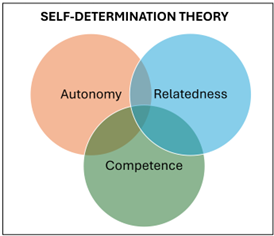
Workshop 8 focuses intensely on leadership. In leadership coaching, the idea is for leaders to develop other leaders. In order for this to occur, both coach and coachee must have a firm grasp on the places where management, supervision, leadership, and coaching separate themselves. The program holds two theories as central to leadership development and creating a culture of self-motivating leadership: Transformational Leadership Theory (TLT) and Self Determination Theory (SDT). Participants will learn the differences and proper placements of both transformational and transactional leadership behaviors. Both coach and coachee benefit from this approach. The coach uses TLT and SDT to advance the coachee, and the coachee learns to pass on effective leadership practices to their team members.
Participants will return to coaching content in the next workshop (9). Because we are dealing with humans in the workplace, we know that leadership and coaching include challenges. The coaching engagement is not always smooth and easy. Leaders need to be able to recognize when their coachee is struggling with any particular areas of their Leader Plan, and they should be equipped to help negotiate challenging conversations. We will cover tools for applying when coaching is not sufficiently working (such as addressing the Expectation/Reality Gap [ERGO]).
Coaches will learn how to assist coachees in designing their own signals for intentionally “triggering” desired or new behaviors. This attention to coaching challenges will include conflict resolution and change management (Prochaska’s 6 Stages of Change) as well.
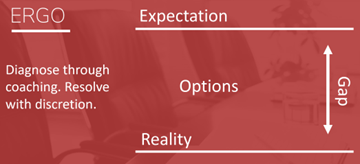
In the closing stages of the program, Workshops 10 and 11 will lift leaders back to a higher level of thinking by delving into the characteristics of the overall leadership culture being pursued. Returning to the principle that coaching is a mindset before it is an event, leaders will practice informal coaching and negotiate the cultural continuum from competence to opportunity, and then to expectation. These workshops will also cover highlights of employee engagement and how leadership coaching influences multiple engagement drivers. Leaders and managers will learn the differences between the hygienic employment factors their employees expect and the motivating factors that drive a leadership culture.
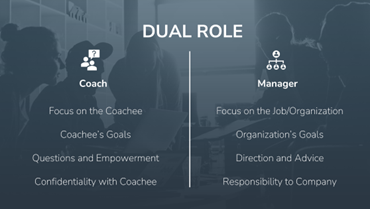
Workshop 12 will allow space for the participants to review all of the tenets covered in the program, work on their own Leader Plans, and compose action commitments toward applying a coaching strategy to the leadership of their team.
Industries
This service is primarily available to the following industry sectors:

Banking & Financial Services
By the time we entered the 21st century, the banking and finance sector had transformed into a massive entity that played a vital role in the U.S. Economy. The sector’s workforce saw significant growth, reflecting its expanding importance. Various financial professionals, such as investment bankers and personal finance advisors, became key players in driving economic growth. The industry’s assets and market capitalization skyrocketed, making it one of the largest and most influential sectors in our economy.
Today, the banking and finance sector in the United States stands as a strong pillar of economic stability, known for its vast size, technological advancements, and regulatory framework. As of 2023, this industry plays a significant role in the country’s GDP, contributing trillions of dollars to its economic impact. Not only does it facilitate the movement of capital and credit necessary for economic growth, but it also provides employment opportunities for millions of individuals, making it a crucial component of the job market.
The workforce composition within this industry has evolved over time to reflect broader societal changes. There is now an increasing emphasis on diversity in terms of gender, race, and backgrounds. This shift highlights a move towards creating an inclusive financial landscape. Additionally, the skillset required within this sector has expanded beyond traditional banking expertise to include proficiency in technology and data analysis. This transformation is due to the digitization of financial services.
In terms of scale, a few major players dominate the industry – large institutions that manage assets worth billions and have a significant impact on global financial trends. However, there are also community banks and fintech startups present throughout the landscape. These smaller entities contribute to a dynamic ecosystem that caters to diverse financial needs.
The significance of technology cannot be overstated in today’s digital era—particularly within this sector, where it has revolutionized various aspects. The way people and businesses engage with financial institutions is being transformed by online banking, mobile financial services, and investment strategies guided by algorithms. This shift towards digital platforms brings both benefits, such as improved efficiency and accessibility, as well as challenges like cybersecurity and regulatory compliance.
In response to the financial crisis of 2008, there has been increased regulatory oversight which now characterizes the current landscape. The Dodd-Frank Act, along with other regulations, has significantly influenced the industry by introducing stringent measures to ensure both financial stability and consumer protection. While these regulations are necessary to prevent risks to the system as a whole, they also impose costs on institutions in terms of operation and compliance.
Looking ahead, it seems like the banking and finance industry in the United States is on the brink of significant changes. These changes will be driven by advancements in technology, evolving regulations, and shifts in economic patterns. Exciting developments like blockchain, cryptocurrency, artificial intelligence (AI), and machine learning are expected to reshape how financial institutions operate and serve their customers.
Blockchain technology holds great potential for bringing about more transparency and security in banking. It could revolutionize areas such as payment systems and fraud prevention. On the other hand, AI and machine learning are set to personalize financial services even further, improve risk assessment models, and simplify regulatory compliance through automated systems.
We can also expect some changes in the workforce composition of this industry. There will likely be a greater emphasis on professionals who are tech-savvy and capable of navigating the intersection between finance and technology. This shift may redefine job roles within the sector, creating new categories of jobs that require continuous upskilling.
Another important trend we can anticipate is an increased focus on sustainability and socially responsible investing. As public awareness grows regarding environmental issues and social concerns, there is a rising demand for financing options that prioritize ethical criteria and sustainable practices. This change not only aligns with moral values but also presents significant market opportunities for forward-thinking financial institutions.
Regulatory frameworks are expected to adapt in response to these technological advancements and changes in society. Striking a balance between promoting innovation and safeguarding consumers and financial stability will be a major challenge for regulators. We can anticipate an ongoing conversation between financial institutions, regulatory bodies, and technology providers to ensure a secure, efficient, and inclusive financial system.
In short, the banking and finance industry in the United States is entering a new era characterized by digital innovation, regulatory transformations, and evolving consumer expectations. Its role as a vital driver of the US economy will persist as the industry adjusts and evolves to tackle the opportunities and challenges of the 21st century.
Manufacturing
The manufacturing industry in America has a rich history that closely intertwines with the nation’s growth and progress. It has been a symbol of American innovation and economic strength, evolving from small workshops to large-scale factories over the years. The advent of globalization and the growth of manufacturing in countries with lower labor costs resulted in a decline in certain manufacturing industries within the United States. Additionally, there was an increase in automation, which improved efficiency but also led to a decrease in employment opportunities and a shift in required skill sets.
However, it is important to note that despite these challenges, manufacturing has continued to play a significant role in the U.S. Economy. It contributes substantially to the GDP and provides employment for millions of Americans. The workforce within this sector has also evolved, placing greater emphasis on advanced skills such as automation, robotics, and computer-aided design and manufacturing.
Today, the resilience and adaptability of the U.S. Manufacturing sector are evident. While it no longer dominates the economy as it once did, it continues to play a crucial role by contributing trillions of dollars to the GDP and employing a significant portion of the workforce. The sector is known for its diversity, encompassing a wide range of industries such as automotive, aerospace, pharmaceuticals, and electronics.
The composition of the manufacturing workforce has significantly evolved over time. The sector now requires a combination of traditional skills and advanced technical knowledge to keep up with the integration of digital technologies in manufacturing processes. Industry 4.0 has brought about smart factories where automation and data exchange are at the core.
This technological shift presents both opportunities and challenges. On one hand, it has resulted in increased productivity, innovation, and the creation of highly skilled jobs. On the other hand, it has also widened the skills gap due to an increasing demand for workers with advanced technical expertise that surpasses supply. Moreover, this sector faces ongoing obstacles related to global competition, trade policies, as well as disruptions in supply chains. There is also a growing emphasis on environmental sustainability within manufacturing circles where manufacturers are adopting greener practices and technologies. The reason behind this change is a combination of government regulations, increasing consumer interest in sustainable products, and the realization of the long-term economic advantages that come with sustainability.
Even though there are obstacles to overcome, the manufacturing industry in the United States continues to excel globally in terms of innovation and production. Its contribution to the economy goes beyond just direct output and employment. It also has a significant impact on other sectors like services and logistics, highlighting its essential role in the broader economic system.
The future of manufacturing in the United States stands at an exciting crossroads, influenced by advancements in technology, changing global dynamics, and evolving domestic policies. The integration of cutting-edge technologies like artificial intelligence, robotics, and the Internet of Things (IoT) is expected to bring about significant transformations in the industry.
One notable trend is the shift towards intelligent manufacturing, where factories are becoming increasingly automated and interconnected. This transition holds the promise of enhanced efficiency, flexibility and personalized production capabilities that enable U.S. Manufacturers to compete on a global scale effectively. However, it also requires a workforce that is adept at utilizing new technologies and adaptable to evolving production methods.
Another important trend is the resurgence of domestic manufacturing. Factors such as rising labor costs in countries traditionally known for low-cost production, trade uncertainties, and a desire for more closely knit supply chains have contributed to a growing movement to bring manufacturing back to the United States. This trend has the potential to generate employment opportunities and stimulate economic growth within the country.
Sustainability will continue to be a major focal point with manufacturers investing in eco friendly technologies and sustainable practices. Not only is this shift environmentally crucial but it is also increasingly recognized as a competitive advantage in a market where both consumers and businesses prioritize sustainability.
The industry may also experience a rise in government assistance and involvement as policies are implemented to enhance local production, invest in skill development, and encourage innovation. This support can play a vital role in preserving the sector’s international competitiveness and tackling issues like the shortage of skilled workers and infrastructure requirements.
Healthcare
The healthcare sector in the United States is a complex and diverse industry that has a fascinating history reflecting changes in society, technology, and the economy. From basic medical practices in the 18th century to our advanced healthcare system today, this journey demonstrates America’s commitment to innovation and better health outcomes. In the latter half of the 20th century and the beginning of the 21st century, the healthcare system in the United States expanded into a massive industry, providing employment to millions and contributing significantly to the national GDP.
Despite making progress, several challenges confront the U.S. Healthcare system. These included escalating expenses, disparities in access to care, and variations in care quality. As a response to the growing intricacy of healthcare delivery, not only have medical professionals played a crucial role but also an extensive range of support and administrative positions emerged within this sector.
Today, the healthcare industry holds importance in the United States, playing a role in both the economy and society. It employs a range of professionals, including doctors, nurses, healthcare administrators, and technology experts. Its impact on the country’s GDP is significant. What makes this sector unique is its evolution, driven by advancements in technology, pharmaceuticals, and healthcare delivery methods. The adoption of electronic health records (EHRs), telemedicine, and personalized medicine are examples of how technology is transforming the field of healthcare.
However, this industry also faces challenges. Healthcare costs in the United States rank among the highest, leading to criticisms regarding inefficiencies and disparities in accessing quality care. In 2010, extensive efforts were made through the Affordable Care Act (ACA) to address these concerns by expanding insurance coverage and implementing measures to improve care quality while reducing expenses. Despite these reforms, debates on healthcare policy remain contentious within politics and public policy discussions. Moreover, an aging population presents complexities for this sector as it necessitates increased healthcare services in areas like geriatric care and managing chronic diseases.
The changing demographics challenge the workforce requirements and financial considerations in delivering healthcare. The significance of the healthcare sector has witnessed growth due to factors and public health concerns exemplified by the global impact of the COVID-19 pandemic. This crisis has emphasized the necessity for responses, a resilient public health infrastructure, and advancements in research for vaccine development.
Looking forward, the healthcare industry in the United States stands at the forefront of innovation and change. Several important trends will shape its future, including advancements in technology, shifts in healthcare policies, and evolving demographic patterns.
One significant driver of change in healthcare will be technological innovation. Advancements in areas such as genomics, artificial intelligence (AI), and digital health are expected to bring about significant transformations in how healthcare is delivered and its outcomes. Personalized medicine, made possible by breakthroughs in genomics and data analysis, holds great promise for providing tailored and more effective treatments. Additionally, AI and machine learning have the potential to revolutionize diagnostic imaging, disease prediction, and healthcare management.
As technology evolves within the industry, so too will the healthcare workforce. There will be an increasing demand for professionals with expertise in health informatics, data analysis, and digital health technologies alongside traditional medical roles. Interdisciplinary collaboration is also likely to become more prevalent as professionals strive to keep up with rapid advancements through continuous professional development.
Policy changes will play a crucial role in shaping the industry’s trajectory. Ongoing efforts to reform healthcare financing systems, improve accessibility to care services, and enhance care quality will continue to dominate public discussions. Navigating these policy shifts while maintaining a focus on innovation and patient-centered care will be paramount for the industry. Furthermore, demographic changes—particularly an aging population—will have profound implications for both healthcare demand and service delivery. This change is expected to result in an increase in fields like elderly care, services for patients at home, and the management of chronic diseases.
Ultimately, the significance of sustainability and public health will continue to grow, placing emphasis on preventative care, promoting good health, and addressing the factors that influence health. The COVID-19 pandemic has underscored the necessity for healthcare systems that are resilient and can quickly adapt to public health crises.
Retail
The retail industry in the United States is an ever-evolving sector that reflects the cultural changes of our nation. Throughout history, from the days of local stores and traveling salespeople to the emergence of department stores and shopping malls in the 20th century, and now with the rise of online shopping in the 21st century, retail in America has continuously adapted to meet consumer demands and leverage technological advancements.
The retail sector has always been of importance to the United States economy. It not only drives sales and generates revenue but also provides numerous job opportunities. This industry encompasses roles such as salespeople, managers, buyers, supply chain experts, and, recently, IT and e-commerce specialists.
The retail industry in the United States is a complex and ever-changing sector that combines both traditional physical stores and rapidly growing online sales channels. It plays a crucial role in the country’s economy, contributing trillions of dollars to the GDP and employing millions of people nationwide. This industry is undergoing significant transformation due to shifting consumer preferences and advancements in technology. The COVID-19 pandemic has particularly fueled the exponential growth of e-commerce, as more consumers have turned to online shopping. As a result, there has been increased investment in digital platforms, logistics networks, and strategies that integrate both physical stores and online shopping experiences.
Although online retail has grown substantially, brick-and-mortar stores continue to be essential because they provide unique experiences that cannot be replicated on digital platforms. Retailers are reimagining the purpose of physical stores by introducing concepts like experiential retail, where stores offer distinctive experiences, as well as showrooming, where they serve as display centers for online purchases.
However, the industry also faces challenges such as fierce competition, narrow profit margins, and the need to adapt quickly to changing consumer behaviors and expectations. Retailers also grapple with disruptions in their supply chains while striving to find a balance between efficiency and sustainability in their operations. Additionally, there are evolving dynamics within the workforce of this sector. The increasing popularity of online shopping and advancements in technology have led to a growing need for individuals who possess expertise in digital marketing, data analytics, e-commerce logistics, and other roles related to traditional retail.
The retail industry in the United States is on the brink of a significant transformation due to technological advancements, shifting consumer behaviors, and broader economic trends. This transformation will be influenced by various factors, including the integration of technology into operations, the growing significance of sustainability, and changes in consumer-retailer interactions.
Exciting advancements such as AI, augmented reality (AR), and the Internet of Things (IoT) are set to revolutionize different aspects of retail. AI and machine learning will enhance shopping experiences, streamline inventory management processes, and improve customer service. AR has the potential to completely change the way we shop by allowing customers to visualize products in their surroundings before making a purchase.
Sustainability is gaining increasing importance in this sector as consumers become more conscious about social issues. This heightened awareness is driving demand for sustainable products and practices. Retailers are responding by adopting sustainable supply chains, minimizing packaging waste, and offering eco-friendly products. The concept of retail as a service is expected to gain momentum. Retailers are focusing on enhancing customer engagement and loyalty through value-added services and memorable experiences that go beyond mere transactions. The ultimate goal is to build strong relationships with customers.
The retail industry is undergoing changes that place greater importance on skills such as literacy, customer service, and adaptability. Industry experts anticipate that the customer service industry will witness a harmonious fusion of technology and human interaction, with technology playing a supportive role rather than entirely replacing it.
Technology
The technology sector in the United States has a history of evolution and groundbreaking innovation. Starting from the era of the telegraph and telephone and progressing to the emergence of the internet and smartphones in times this industry has been at the forefront of transforming not only American society but also impacting the entire world. In this century, we continue to witness growth in America’s technology industry. The sector plays a role both in the health of local economies and on a global scale. The advent of media, mobile technology, and cloud computing has revolutionized our world by integrating technology into our lives.
Today, the technology industry in the United States is a vital part of our economy. It leads the world in innovation and sets trends across sub-sectors such as software, hardware, and internet services. Not only does this industry significantly contribute to our GDP, but it also serves as a major employer, attracting some of the brightest talents from around the globe.
What distinguishes this sector is its pace of innovation and fierce competition. Companies are constantly pushing boundaries in areas like artificial intelligence (AI), machine learning, big data, and the Internet of Things (IoT). These technologies not only propel the sector forward, but they also have transformative effects on other industries ranging from manufacturing to healthcare. A noteworthy aspect of today’s tech landscape is the dominance of a few players often referred to as “Big Tech.” These companies wield influence over both markets and consumer behavior. However, it’s important to acknowledge that there is also a startup culture within this ecosystem. Numerous medium-sized enterprises play a role in driving innovation.
The workforce within the technology sector is diverse, encompassing roles such as software developers, data scientists, digital marketers, and user experience designers. However, along with its successes come challenges. Concerns about privacy protection, cybersecurity measures, and ethical considerations surrounding AI and emerging technologies are among the issues that require attention.
Looking ahead, the future of the technology sector in the United States appears promising, with growth and innovation expected. Several key trends are anticipated to shape this future. The continuous development and application of AI and machine learning are forecasted to bring about opportunities and challenges that will impact aspects, including job markets and societal norms. The expansion of 5G networks and the continued growth of IoT (Internet of Things) are set to revolutionize connectivity, enabling a fresh wave of technological advancements. These advancements have the potential to bring changes in areas such as vehicles, smart cities, and remote healthcare.
Another notable trend is the increasing emphasis on data privacy and security. As technology becomes increasingly integrated into our lives, there is growing concern among consumers and governments regarding the use and protection of data. This concern is likely to result in regulations being implemented and changes in business practices.
Sustainability and climate change are also emerging as issues within the tech sector. There is a rising focus on developing technologies that reduce the impact associated with digital infrastructure, ranging from data centers to device manufacturing. Furthermore, it is expected that the tech workforce will continue evolving with an increasing demand for skills in areas like AI, cybersecurity, and cloud computing. Additionally, as technology continues to permeate industries, digital literacy will become a skill within a broader job market.
Locations
This service is primarily available within the following locations:

Charlotte, NC
Charlotte, North Carolina, has experienced remarkable growth and transformation, becoming a major U.S. financial hub and an expanding center for various industries. Several key factors have contributed to this growth, shaping Charlotte’s business landscape and economic development.
Today, Charlotte, North Carolina, stands as a vibrant and rapidly growing city known for its robust economy, diverse industries, and dynamic cultural landscape. At the heart of Charlotte’s economic prowess is its status as a major U.S. financial hub, in terms of banking assets and influence. The presence of major financial institutions like Bank of America and the East Coast operations of Wells Fargo drives much of the city’s economic activity, offering numerous employment opportunities and attracting related businesses in finance, legal, and consulting services.
Beyond finance, Charlotte has diversified its economic base significantly. The city is a flourishing center for the energy sector, with Duke Energy headquartered here, and a growing cluster of energy-focused firms and startups. This sector’s expansion reflects Charlotte’s commitment to innovation and sustainable development.
The healthcare industry is another key pillar of Charlotte’s economy, with major systems like Atrium Health and Novant Health providing not only essential services but also contributing substantially to the job market. Additionally, the city’s technology sector is on the rise, with a growing tech scene fueled by both startups and established companies, making Charlotte a respected player in the tech industry.
Charlotte is a major hub for American Airlines, headquartered in Ft. Worth, TX. Charlotte is also well known for its vibrant motorsports industry, with multiple NASCAR teams and the Charlotte Motor Speedway located in the metro area, underscoring its reputation as a hub for motorsports.
Quality-of-life attractions complement these economic drivers. The city boasts a rich cultural scene, with institutions like the Blumenthal Performing Arts Center and the Mint Museum, alongside a thriving culinary scene that reflects the city’s diverse population. Outdoor enthusiasts enjoy the proximity to both mountains and coast, as well as numerous local parks and greenways.
Moreover, Charlotte’s commitment to education and workforce development, with institutions like the University of North Carolina at Charlotte, ensures a steady pipeline of skilled talent, supporting the growth of key industries and attracting new businesses.
The projected outlook for Charlotte is one of continued growth and economic vitality, positioning it as a city with a promising future. Economically, there is no reason to believe that Charlotte will not maintain its trajectory as a significant banking and financial center, with the presence of major institutions like Bank of America and Wells Fargo providing a stable foundation. This sector is likely to continue driving job creation and attracting complementary businesses in finance, legal, and consulting services.
Charlotte’s economy is diversifying, showing great potential in several key areas. The energy sector, led by companies like Duke Energy, is poised for growth, particularly in areas of sustainable and renewable energy technologies. This aligns with global trends towards greener energy solutions and positions Charlotte as a player in this crucial industry.
The healthcare and technology sectors in Charlotte are also areas of notable potential. With major healthcare providers and a growing biotech presence, the city is becoming a hub for medical innovation and services. The technology sector, fueled by a mix of startups and established tech companies, is expanding, driven by the city’s efforts to foster a supportive environment for innovation and entrepreneurship.
Charlotte’s commitment to education and workforce development, with institutions like the University of North Carolina at Charlotte, ensures a steady supply of skilled talent, which is essential for sustaining economic growth and attracting new businesses. This focus on education also contributes to the overall welfare and quality of life in the city.
In terms of general welfare, Charlotte is expected to continue investing in infrastructure, cultural institutions, and quality-of-life enhancements. These investments not only attract new residents and businesses but also contribute to the well-being of the community.
The greatest potential for Charlotte to remain a thriving U.S. city lies in its ability to balance growth with sustainability. By continuing to diversify its economy, invest in education and infrastructure, and foster a business-friendly environment, Charlotte is well-positioned to adapt to the changing economic landscape and maintain its status as a vibrant and prosperous city.
Atlanta, GA
Atlanta has a rich and complex history that has significantly shaped its economic and cultural landscape. Atlanta’s economic history in the 20th century is marked by diversification. The city became a hub for manufacturing and trade and, later, a center for civil rights activism, playing a crucial role in this national movement. The latter half of the century saw a boom in the city’s real estate market and the establishment of major corporations like Coca-Cola, which became synonymous with Atlanta’s global identity.
The 1996 Summer Olympics marked a significant milestone, putting Atlanta on the international stage and spurring a wave of urban revitalization and economic development. This period also saw the growth of Atlanta’s airport, Hartsfield-Jackson, which became one of the busiest airports in the world, reinforcing the city’s status as a transportation powerhouse.
Today, Atlanta stands as a vibrant, bustling metropolis renowned for its diverse economy, rich cultural scene, and its role as a leading transportation hub. The city’s economy is remarkably diverse, with strong sectors in logistics, professional and business services, media operations, and information technology. Atlanta’s status as a transportation and logistics powerhouse continues, anchored by the Hartsfield-Jackson Atlanta International Airport, which facilitates business and tourism.
The city is also a significant media hub; it is home to major corporations like CNN and Turner Broadcasting System, reflecting its influence in the communications and entertainment industries. Additionally, Atlanta’s IT sector is thriving, with a growing reputation as a tech hub, particularly in fintech and health IT, attracting startups and established tech companies alike.
Atlanta’s cultural richness adds to its appeal. The city boasts a vibrant arts scene, including renowned institutions like the High Museum of Art and the Atlanta Symphony Orchestra, alongside a thriving music industry, particularly in hip-hop and R&B. The presence of major educational institutions like Georgia Tech and Emory University contributes to a dynamic and educated workforce, fostering innovation and development.
The city’s quality of life is enhanced by its diverse neighborhoods, extensive park systems, and a culinary scene that reflects its multicultural population. These factors, combined with a relatively affordable cost of living compared to other major U.S. cities, make Atlanta an attractive place for professionals and families.
The future outlook for Atlanta is one of continued growth and innovation. Economically, the city is poised to strengthen its position as a hub for logistics, media, and technology. The ongoing expansion and modernization of the Hartsfield-Jackson Atlanta International Airport are expected to further enhance Atlanta’s connectivity and global reach, crucial for its logistics and transportation sectors.
In the realm of technology, Atlanta is set to solidify its status as a valuable tech hub. The city’s focus on fostering a supportive environment for startups, combined with the presence of established tech giants, positions it well for continued growth in this sector. This is particularly true for fintech, where Atlanta already has a strong foothold, and health IT, which is expected to grow with advancements in medical technology and digital health.
Atlanta’s economy is also likely to benefit from its well-established role as a media and entertainment center. The city’s film and music industries are thriving, supported by favorable tax incentives and a rich cultural heritage. This sector’s growth not only boosts the economy but also enhances the city’s cultural vibrancy and global appeal.
Moreover, Atlanta’s commitment to education and workforce development, with its array of prestigious universities and colleges, ensures a continuous supply of skilled talent vital for sustaining economic growth and innovation. The city’s focus on sustainable development, as seen in initiatives for green spaces and public transportation, will also contribute to its appeal as a desirable place to live and work.

Miami, FL
Miami’s rich history is a vibrant mosaic of various influences and dynamic changes. Miami’s transformation into a popular tourist spot began in the early 20th century, thanks to its inviting weather and stunning coastlines. Miami’s rise as a hub for global trade and finance, especially as a key entry point to Latin America, was a defining feature of the latter half of the 20th century. Its prime location attracted numerous businesses and financial institutions specializing in global commerce.
Miami has transformed into a bustling city known for its rich cultural diversity and thriving economy. The city’s tourism, finance, real estate, and international trade sectors are particularly strong, contributing to its vibrant atmosphere. The city’s rich blend of cultures, with a strong influence from Latin American and Caribbean traditions, contributes to its distinct charm and lively atmosphere.
Miami’s economy thrives on tourism, as it serves as a major cruise port and a sought-after hotspot for travelers from around the world. Miami’s finance sector, particularly in international banking, is a significant economic force, leading to its reputation as the “Wall Street of the South.”
The real estate market in Miami is experiencing strong and sustained growth, fueled by a combination of local and international investments. The city’s skyline, adorned with towering buildings and upscale properties, is a clear reflection of the thriving real estate market.
Miami is a vibrant cultural center known for its thriving arts and entertainment scene. The city is home to prestigious events such as Art Basel and the Miami International Film Festival. The city’s culinary scene is a true delight, showcasing a rich tapestry of flavors and influences from around the world.
Education is a crucial factor in the growth of Miami, thanks to esteemed institutions such as the University of Miami and Florida International University. These schools not only produce a talented workforce but also foster groundbreaking research.
Miami’s future is filled with promise and excitement as its economy and cultural scene are set to flourish even more. The city’s advantageous location as a gateway to Latin America will further enhance its significance in global trade and finance. Miami’s economy is expected to be strongly influenced by the finance sector, with a particular emphasis on international banking.
Tourism is expected to remain a significant driver of the economy, supported by investments in hospitality and entertainment. The city’s reputation as a premier cruise destination will also contribute to the growth of this industry. Despite the obstacles posed by climate change and rising sea levels (as well as its vulnerability to hurricanes), the real estate market is projected to maintain its strength due to ongoing demand and investment.
Miami’s technology sector is rapidly growing, with a particular focus on fintech and health tech. The potential for success in these industries is quite promising. The city’s proactive initiatives to attract tech talent and startups, combined with its vibrant entrepreneurial culture, establish it as a respected tech hub.
Miami’s rich cultural diversity and vibrant arts scene are poised to thrive, further elevating its global allure. The city’s dedication to cultural events and institutions is sure to draw a wide range of people and tourists, enhancing its cosmopolitan atmosphere.
Nevertheless, Miami encounters various obstacles, such as environmental issues like hurricanes and sea-level rise, as well as social challenges like income inequality. Tackling these obstacles by prioritizing sustainable development, investing in infrastructure, and implementing inclusive policies will be essential for Miami’s ongoing expansion and success.
Dallas, TX
Dallas, Texas has a fascinating history that has greatly influenced its economic and cultural development. Dallas has cultivated a distinct identity that seamlessly combines its rich Texan roots with a contemporary and cosmopolitan vibe. The city has gained a reputation for its vibrant arts scene, eclectic music scene, and diverse culinary offerings, all of which reflect the diverse influences brought by its population.
Today, Dallas is a thriving American metropolis known for its vibrant economy, diverse culture, and reputation as a strong commercial and cultural center. The city boasts a thriving and robust economy, which is among the largest and most diverse in the United States. It is home to flourishing sectors in technology, finance, defense, and telecommunications.
Dallas plays a crucial role as a corporate headquarters city, boasting a multitude of Fortune 500 companies that call this place home. Some notable names include AT&T, Southwest Airlines, and Texas Instruments. The concentration of corporate headquarters has been a driving force behind economic growth and job creation in multiple sectors.
Dallas’s economy is greatly influenced by the technology sector, which has a significant presence in telecommunications, information technology, and software development. The city’s “Telecom Corridor” showcases its significant role in the telecommunications industry, with a dense cluster of telecommunications companies.
Dallas plays a crucial role in the finance industry, serving as a prominent center for banking and financial activities. With its prime location and strong infrastructure, the city has become a vital logistics and distribution center, contributing to its thriving economy.
Dallas is widely recognized for its vibrant arts and entertainment scene. The city is proud to have a lively arts district, which is home to renowned institutions such as the Dallas Museum of Art and the Winspear Opera House. Dallas boasts a remarkable culinary scene, offering a wide range of dining choices that beautifully showcase its multicultural population.
Education is a key driver of the city’s development, as esteemed institutions such as Southern Methodist University and the University of Texas at Dallas cultivate a talented workforce and nurture a culture of innovation.
Dallas is poised for a future of sustained expansion and a broadening of its economic base. The city’s economy is primed for continued growth in various key sectors, building upon its already strong and diverse foundation.
Dallas’s economic growth is expected to continue being driven by technology and telecommunications. The city’s well-developed infrastructure and highly skilled workforce in these sectors create a strong base for future growth, especially in promising fields such as cybersecurity and digital media.
The finance sector is expected to experience ongoing growth, as Dallas’s status as a prominent banking sector continues to attract additional investment and job opportunities. In addition, the strategic location and transportation infrastructure of the city will ensure its ongoing importance as a key logistics and distribution center.
The real estate market in Dallas has great potential for growth. The city is experiencing a surge in population and economic growth, leading to a high demand for residential and commercial properties. Numerous development projects are currently underway throughout the city.
Dallas is poised to solidify its standing as a major player in arts and entertainment, bolstering its cultural reputation. The cultural landscape of the city will be further enriched through investments in cultural institutions and events, as well as the presence of a diverse population.
Investing in education and workforce development will continue to be vital for the future success of Dallas. The universities and colleges in the city play a crucial role in fostering talent and driving innovation, especially in thriving sectors such as technology and finance.

Phoenix, AZ
The rich and diverse history of Phoenix spans over several centuries. From its humble beginnings as a small agricultural community to its current status as a major metropolis, Phoenix has undergone remarkable transformations. Phoenix experienced substantial growth throughout the 20th century, particularly in the finance, insurance, real estate, and technology sectors. During the Cold War era, the city experienced a surge in aerospace and electronics industries. Notably, companies such as Motorola played a significant role in establishing their presence here.
Phoenix’s rich cultural tapestry is a vibrant blend of Native American, Hispanic, and Anglo-American influences. This diverse heritage permeates every aspect of the city, from its arts and cuisine to its lively community events. Phoenix has managed to preserve its historical roots and embrace the natural beauty of the Sonoran Desert, even as it continues to experience rapid growth.
Today, Phoenix is recognized as the fifth-largest city in the United States by population and 11th by area, celebrated for its thriving economy and vibrant cultural heritage. The city has transformed from its agricultural and industrial origins into a vibrant and contemporary urban hub.
Phoenix boasts a diverse economy, with robust sectors in real estate, healthcare, retail, and technology. The city’s impressive growth can be attributed to its welcoming business environment, characterized by affordable living costs and policies that are favorable to businesses. This combination has attracted a diverse range of companies and industries.
The city’s economy benefits greatly from the healthcare and biotechnology sectors, as major healthcare providers and an increasing number of biotech companies have chosen to establish themselves in the area. Phoenix is quickly becoming a hot spot for tech startups and established tech companies in the technology sector. One of the reasons for this is the lower operational costs compared to other major tech hubs.
The real estate market remains a significant force in driving the economy as the city’s population growth continues to generate a strong demand for both residential and commercial properties. The rapid expansion has sparked a construction frenzy as fresh developments and infrastructure initiatives reshape the urban landscape.
Phoenix is a city that embraces its cultural diversity, showcasing a vibrant arts scene, a wide range of culinary delights, and a calendar full of cultural festivals that honor its rich heritage. The city is renowned for its abundant outdoor recreational options, including hiking, golfing, and its close proximity to natural wonders such as the Grand Canyon.
Education plays a crucial role in the growth of Phoenix, as esteemed institutions such as Arizona State University contribute to a highly skilled workforce and cultivate a culture of innovation.
Phoenix is poised for a future of sustained growth and expansion. The city’s economy is projected to continue diversifying, with technology, healthcare, and real estate positioned for further growth and expansion.
The technology sector holds great potential. Phoenix’s growing reputation as an innovation center and its appeal as a more affordable alternative to traditional tech hubs are expected to draw in a greater number of startups and tech companies. The growth in the tech sector is anticipated to fuel the creation of new jobs and promote economic diversification.
The healthcare and biotechnology sectors are poised for growth, fueled by the increasing number of elderly individuals (“Snowbirds”) and advancements in medical technology. Phoenix’s status as a hub for medical innovation and services is bolstered by the presence of leading healthcare providers and research institutions.
Real estate and construction are expected to continue thriving due to the city’s continuous population growth. Managing the rapid growth in Phoenix poses significant challenges in terms of sustainable development, infrastructure, and water resource management, given its desert location.
Phoenix’s cultural scene is expected to continue thriving as investments in arts, music, and community events contribute to the city’s vibrant quality of life. The city’s diverse cultural makeup will contribute to the vibrant social and cultural fabric of the community.
Nevertheless, Phoenix is confronted with various obstacles due to its exponential expansion. These challenges encompass the management of urban sprawl, the imperative to promote sustainable water usage, and the pressing need to address transportation and infrastructure requirements. Tackling these challenges with precision is essential for the city’s enduring sustainability and overall well-being.
Program Benefits
Production
- Building Autonomy
- Building Competence
- Building Relationships
- Building Confidence
- Leveraging Motivation
- Increasing Accountability
- Increasing Retention
- Shared Vision
- Leadership Empowerment
- Building Trust
Human Resources
- Performance Enhancement
- Leader Retention
- Bench Depth
- Increased Engagement
- Succession Planning
- Employee Development
- Enhanced Assessment
- Job Satisfaction
- Team Building
- Conflict Management
Management
- Shared Leadership
- Self Determination
- Leadership Culture
- Improved Relationships
- Effective Delegation
- Management Excellence
- Change Leadership
- Emotional Intelligence
- Effective Communication
- Goal Clarity
Testimonials

The Center for Community Leadership at United Way Worldwide
Dr. Jinks has presented numerous learning programs for our members. He is highly competent in both his ability to facilitate group learning and his content knowledge. We appreciate that he is always prepared, asks questions to be clear about content delivery, shows great enthusiasm for learning, communicates clearly, and facilitates a participatory learning methodology (e.g., he does not just lecture!). TLP’s training always gets high ratings on participant evaluations. Some recent comments from participants include:
“Exceptional ability to stay with the content while adding personal experiences and capitalizing on questions and comments from the participants. We were lucky to have him as an instructor!”
“Dr. Jinks did a fantastic job relating on a personal level. He uses lots of personal stories and anecdotes, which is good for keeping everyone engaged. He was also very sensitive to the varied learning curve and was always willing to stop and review or clarify.”
“I believed Dr. Jinks connected with the class, was sincere in trying to share his knowledge and experience, had an excellent delivery that kept the class flowing…..and equally important, demonstrated his ability to listen and thereby respond effectively to questions.”

Leadership Systems, Inc.
“Some are leadership theorists, and some are leadership practitioners; Dr. Jinks is both. He understands theoretical frameworks, but he has also demonstrated the same leadership he teaches under real-life challenges and has emerged as a true leadership practitioner. As a Board Certified Coach and Certified Adjunct Coach with LSI, he has effectively trained corporate leaders at our Leadership Coaching Training (LCT) seminar. Participants are attracted to Dr. Jinks’ coaching heart and his leadership mind, for both have been refined in the crucible of senior leadership roles dealing with colleagues, senior staff, board leaders, and clients. Dr. Jinks knows leadership. He can pull the best from you, skillfully present, and help you and your team apply leadership principles. The old model of the manager or leader having the answers is going away faster than we ever imagined, so if we’re not investing in our people through coaching and coaching training, we’re falling behind.”

Ervolina Associates
“Dr. Jinks at The Leader’s Perspective understands that process alone will never produce results. They will help you and your team stay focused on action — what needs to happen next and who is going to accomplish it. Dr. Jinks is not just a leadership coach. He’s a coaching trainer and leader who models the leadership he helps others achieve. There are a lot of trainers out there, most of whom are only good at reading PowerPoint slides and handing out photocopied worksheets in a kind of corporate version of a middle school math class. Dr. Jinks distills the essence of a curriculum and gets participants to make it their own.”

Hollingsworth Funds
“TLP coaching develops skills in the folks that they are working with, in that they do the work, and Dr. Jinks is not imprinting his ideas, but he is pulling out their thoughts about the work they are doing and then helps them put it in an effective framework. He allows you to find your voice and your style. That is unique, because you own the work you are trying to do, and it becomes more authentic. As systems thinkers, we understand that you have to have great leaders to make change, so we see it as a worthy investment in the future of our community.”
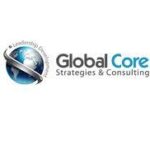
Global Core Strategies and Consulting
“If you ask us what separates Dr. Jinks from others who do what he may do, he is phenomenal at asking questions and identifying the right questions to make us a better organization. He has made a difference in our organization. We leverage his skill sets with our own clients. If we didn’t have TLP’s work, we would not be as fast or as good at our work. TLP does phenomenal work.
Organizations are struggling across the globe with the development of leaders. Leaders lose their perspective because they get trapped by day-to-day activities. TLP helps leaders stay in the cockpit as pilots rather than loading luggage or handing out drinks.”
More detailed achievements, references and testimonials are confidentially available to clients upon request.
Client Telephone Conference (CTC)
If you have any questions or if you would like to arrange a Client Telephone Conference (CTC) to discuss this particular Unique Consulting Service Proposition (UCSP) in more detail, please CLICK HERE.

















